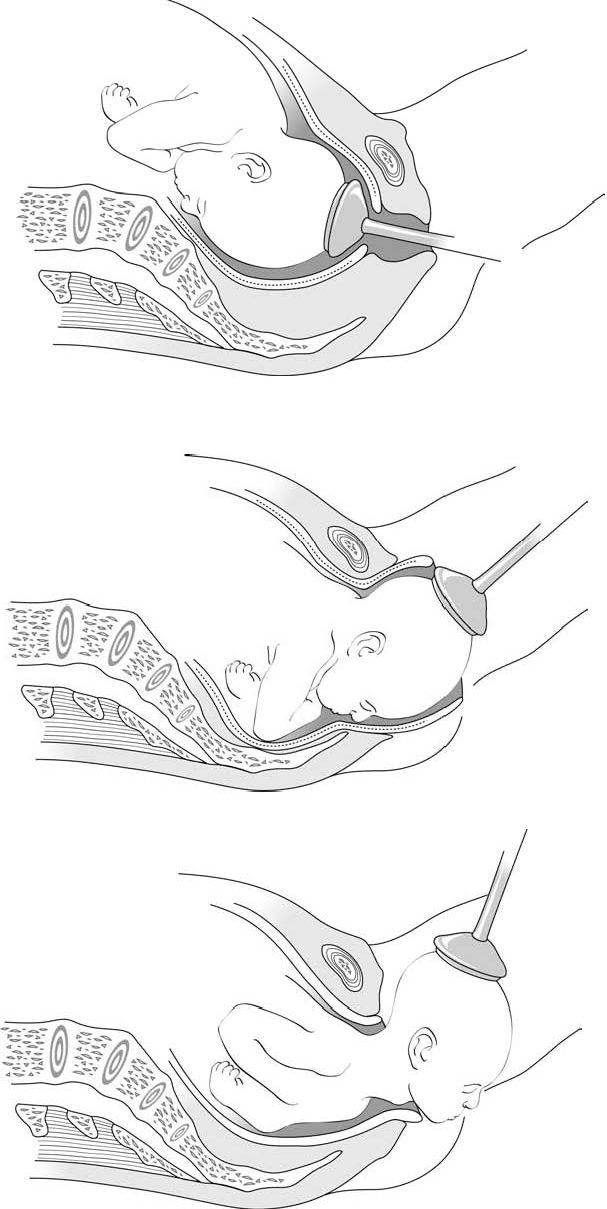The choice of extraction instrument (vacuum extractor or forceps) depends on the experience and skill of the operator.
The conditions for use are the same for both instruments:
- Full dilation.
- Regular uterine contractions.
- Head engaged.
- Accurate diagnosis of the head position.
- Amniotic sac ruptured.
- Bladder empty.
5.6.1 Vacuum extractor
Flexion and traction device for facilitating delivery of the foetus.
There are various models, but all have:
- A metal, plastic or silicone suction cup, which must be sterilized between each patient.
- A connection to a vacuum system controlled by a pressure gauge. The vacuum is produced by means of a manual pump or electrical device.
- A handle for applying traction.
Indications
- Failure to progress due to insufficient or ineffective expulsive effort despite good uterine contractility (using oxytocin, if necessary).
- Foetal distress during delivery.
- Perineum unable to stretch enough (combine with episiotomy).
- Difficulty with extraction during caesarean section (if possible, use a Vacca Reusable OmniCup®-type vacuum extractor with built-in pump).
Contra-indications
- Breech, transverse, face or brow presentation.
- Preterm neonate (< 34 weeks): the bones of the skull are too soft.
- Head not engaged.
- Cervix not fully dilated.
Technique
- Place the woman on her back with knees bent and thighs apart.
- Swab the perineum and the vagina with 10% povidone iodine.
- Empty the bladder (insert a sterile urinary catheter).
- Prepare the sterile part of the instrument (the cup), using sterile gloves.
- Insert the cup into the vagina (Figures 5.15) and apply it to the scalp, as close as possible to the posterior fontanelle—that is, anteriorly for occiput anterior presentations.
- With one hand holding the cup, circle the cup with one finger of the other hand to make sure that no vaginal or cervical tissue is caught under it. Applying traction can tear the cervix or vagina if there is vacuum extractor suction on those tissues (risk of massive haemorrhage).
Figures 5.15 - Inserting the cup into the vagina
- If required have an assistant connect the cup to the vacuum system.
- Hold the cup to the foetus' head with one hand.
- Pump to reach a negative pressure. Check for trapped vaginal or cervical tissue before starting traction. Sit on a small foot rest or kneel; this gives a good traction angle and helps to stay balanced. The traction, applied with the dominant hand, should be perpendicular to the plane of the cup.
- Traction should be applied in sync with the uterine contractions and the pushing, which the woman should continue. Stop pulling the moment the uterine contraction stops. The direction of traction varies according to the head's progress: first downward, then horizontal, then increasingly vertical (Figures 5.16).
Figures 5.16 - Vacuum extractor traction: axis varies depending on the progress of the head
- If the cup is positioned incorrectly or the traction is too sudden, the cup can detach. If this happens, re-apply it (but no more than 3 times).
- When the hand is able grasp the foetus' chin, turn off the suction, remove the vacuum extractor and finish the delivery in the normal fashion.
- While episiotomy is not routine, it can be useful, especially if the perineum is too resistant.
Note: when there is a significant pre-existing caput, application of the vacuum extractor can be ineffective and forceps may be necessary.
Do not apply suction for more than 20 minutes: the indication is probably incorrect, and there is a risk of scalp necrosis. Birth usually occurs in less than 15 minutes.
Make no more than 3 attempts at traction if there is no progress (the mother's pelvis is probably impassable).
In case of failure, perform a caesarean section.
5.6.2 Forceps
The use of forceps requires special expertise, and forceps should be used by trained birth attendant only.
Forceps can be used even without the mother pushing.
Forceps can be used when a vacuum extractor cannot be used as in a mentum anterior face presentation.
Indications
- As for vacuum extraction.
- Breech presentation with retention of the aftercoming head.
Contra-indications
- Transverse lie or brow presentation.
- Head not engaged.
- Cervix not fully dilated.

